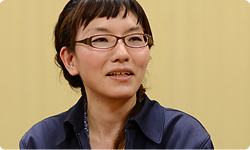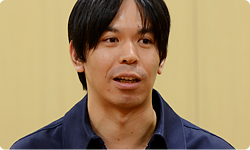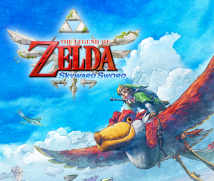3. A Town Designed to Function
At first, the sky functioned like a course selection screen, and later it became a town called Skyloft and changed form into a hub for adventures. Iwamoto-san, as the “sky gang leader,” why would you say that happened?
Skyloft is basically a place where you prepare for adventure. We wanted to make it a kind of home base that you always come back to after having accomplished something.
A place you stop by more than any other.
Yes. But it wouldn’t be fun if all you did was prepare for an adventure and then head out again. By adding in involvements with all kinds of townsfolk, it became a place somewhat away from the adventure that you can explore in a more laid-back fashion.
The most distinctive gameplay in Skyloft is bringing back to town the treasure you have collected on the world surface below and turning it into different things.
That’s right. With treasure, you can do things like power up items and customise your equipment. And there’s a storage shop called the Item Check where you can shuffle around the contents of an Adventure Pouch.
What’s an Adventure Pouch?
To explain it simply, the players think about what kind of Link they want to play when they head down to the surface for a particular adventure and make selections for the items in their pouch accordingly.
There are different kinds of Link?
That’s right. If you stuff in a bunch of potions, you’ll play a tough Link. If you put in a bunch of medals good for collecting various things, lots of treasure will appear.
But there’s a limit to how much you can put in your pouch, so when it’s full, you have to take out what you don’t need.
And there’s a place to store them in the Bazaar, right?
Yes. There are all kinds of shops necessary for your journey there. You can do all sorts of things like buy items, mix potions, or store items. We made the Bazaar so you can do all those things quickly in a single place.
Ah, so that’s why it’s called the Bazaar.
Yes. Hoofing it all over town would take time and be a hassle, so we made it in the centre of Skyloft.
There are multiple entrances so you can access it from anywhere, and we put shops near each other that would be more convenient.
The town is designed with functionality front and foremost. Now I have a question for Hisada-san, who coordinated landform design. Did you get lots of unreasonable requests from the planners?
Oh, yes... Oh, yes! (laughs)
So much that you have to say it twice?! (laughs) How did you interpret those demands and how did you respond to them?
When there was an outrageous request, I would first go, “Huh?!” but then we would all talk it over, and once I understood the essence of what was being asked, I could find a way to achieve it. For example, if someone said, “We want to make a town floating in the sky,” at first I would have no idea where to start.

Because no one has ever seen such a thing. (laughs)
But once the goal became clear - that Link jumps down from there, whistles, and his Loftwing swoops in, and he can go all sorts of places - I thought, “Then we need places for him to jump from,” and prepared jump-off spots here and there around Skyloft so it would be easy to jump down.
In our interviews so far, lots of people have said that the designers made lots of useful suggestions from their point of view.
Along those lines, early on, when we weren’t that busy yet, the designers drew up concept images for the sky and proposed all sorts of ideas.
What would be a good example of something that came about because of the designers’ opinions?
Let’s see...
Batreaux, for example.
Yes. Batreaux is like the surviving member of a clan of demons who wants to become human. A landform designer came up with a concept image for an interesting townsperson, and when we saw that, we thought, “It would be interesting if there were someone like this.” Batreaux came from that.
Is there something unusual about him?
Yes. I can’t go into detail here, but there’s a gap between how he looks and his personality.
I first saw Batreaux at Iwamoto-san’s desk. He didn’t appear to fit The Legend of Zelda at all!
Yes. (laughs)
I thought maybe he was working on a different game than The Legend of Zelda! (laughs)
That’s how unusual Batreaux is.
Yes. He lives in a weird place like an attic.
But if you grant his requests, he’ll give you all sorts of stuff. Iwamoto-san, the character designers and I all came up with lots of ideas for side quests like that.
We put forth ideas, and when it was time to bring them together, I didn’t know whether there were a lot or a little, but when I actually checked, there were loads.
Maybe enough for a whole game.
Huh? Were there really that many?
So above the clouds is dense, too. (laughs)
I see. (laughs) Now, on to sound designer Mizuta-san. Thank you for waiting.
Not at all.
What did you pay special attention to this time when making the sound?
From early on in production, the first thing I wanted to treat with importance was the sound of the wind.
The wind is only one word, but there are actually many different kinds.
Yes. There are lots of different kinds - in the sky and towns to begin with, environment sounds in the game fields and dungeons, the satisfying sound of cutting the air when the bird dives, and so on. There were five people working on sound effects, but we split them up for different kinds of wind.
You divided up the work just for the wind?
Yes. (laughs) Different people were in charge of different areas. Another important one was the sound of the sword. The action of swinging the sword is more important than ever this time, and the title of the game is The Legend of Zelda: Skyward Sword, so I thought, “We’d better pay close attention to the sounds that the sword makes.”

A lot of games pay attention to music, but pouring lots of energy into sound effects is one characteristic of Miyamoto-san’s teams.
That’s right. We always kept that in mind as we made the sound. I also tried to make sure that the staff who joined later also treated the sounds of the sword and wind with care so they would share the same attitude.
And shouldn’t we mention the new musical instrument?
Oh, that’s right. This time, you can play the harp .
The Legend of Zelda series often features musical instruments.
Yes. You can play the harp as you walk , and play along with the background music, so I hope people will enjoy playing it all over the place.
I’m looking forward to that. To discuss the sound a little more, what kind of hurdles did you face with regard to making the sound?
First of all, there were simply loads of things to make sounds for, so that was a big hurdle. We had Mario Club Co., Ltd.5 record all the event scenes and watched those, checking each one. 5Mario Club Co., Ltd.: It conducts debugging and testing on Nintendo software during development.
You mean that you watched the videos to check whether the sounds were appropriate.
That’s right. And when I found events that didn’t have sounds, I listed what music or sound effects were necessary, and used them to discover, for example, what sound wouldn’t fit in a particular place. Being responsible for the sound, I wanted to manage the quality of the whole thing.
I would suppose so.
But despite all that, it still turned out that there were too many.
Ten people still wasn’t enough. (laughs)
Yes. (laughs) So then I asked the planners to select and apply sounds for conversations.
It was my first time to add in my own sounds.
If you used the tool we mentioned, a planner himself could create a simple demo.
Which created another problem. A lot of the time, the content would change while you weren’t looking, or new events would come into being.
That’s right! All of a sudden, there would be more!
All of a sudden, there would be new objects sitting there.
All of a sudden? (laughs)
Yes. Sudden events! (laughs)
